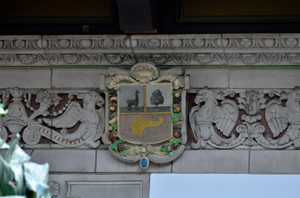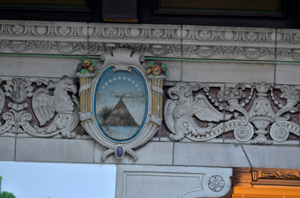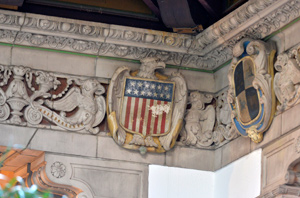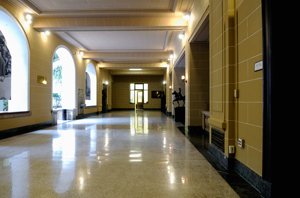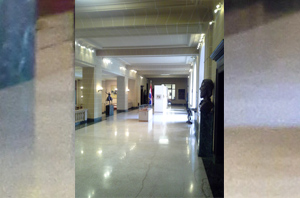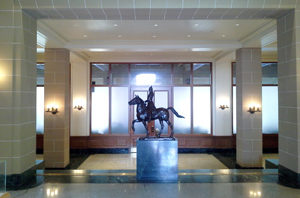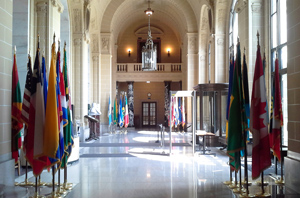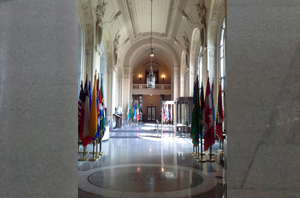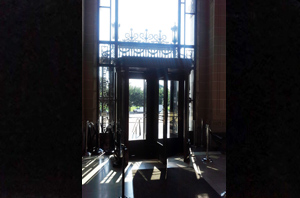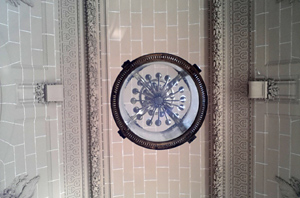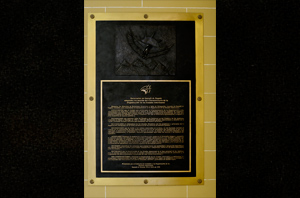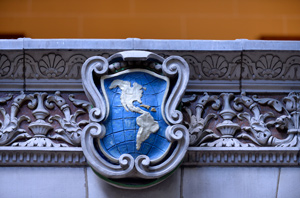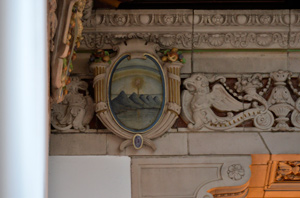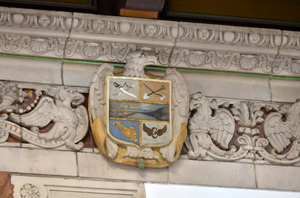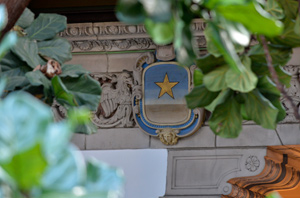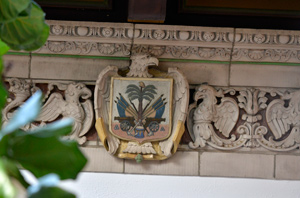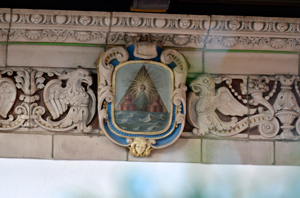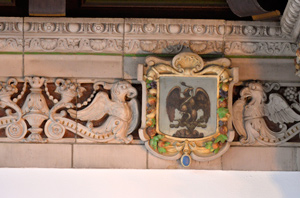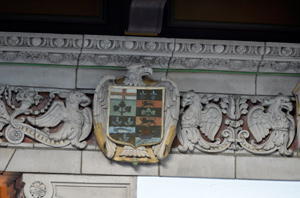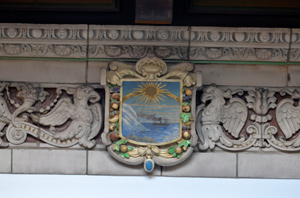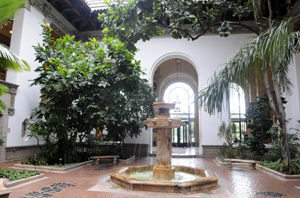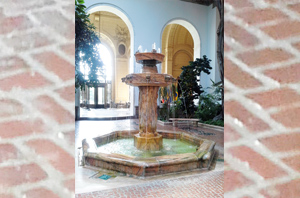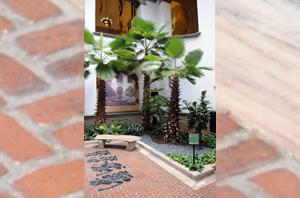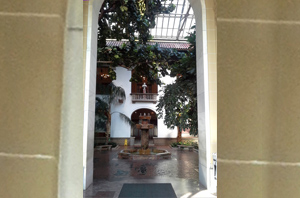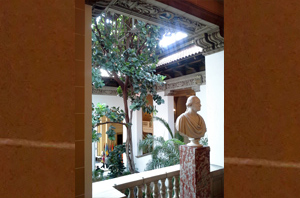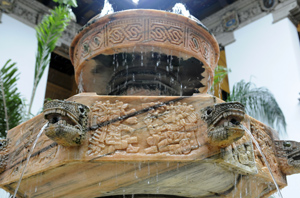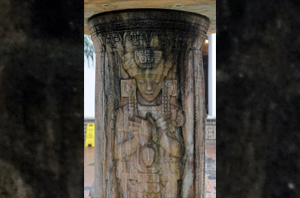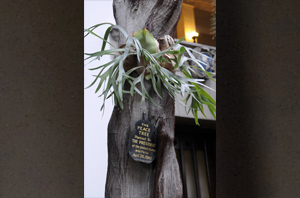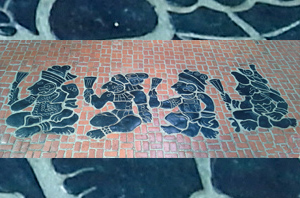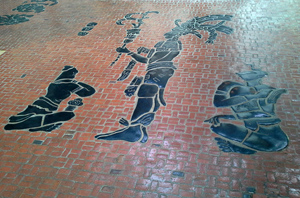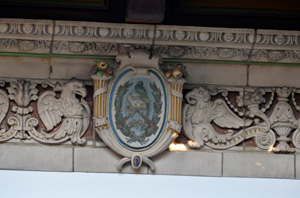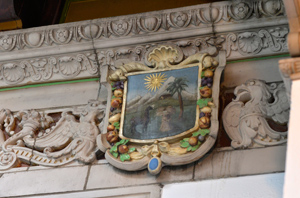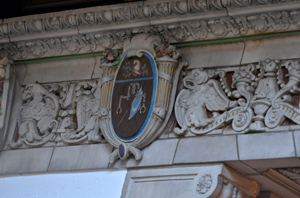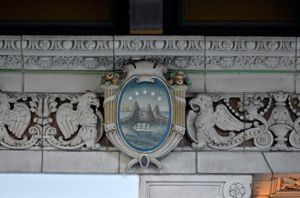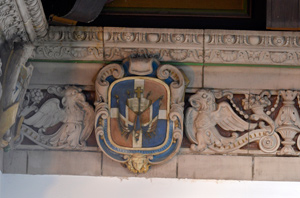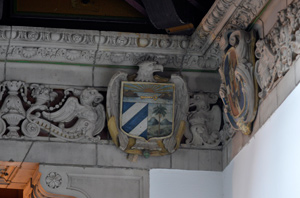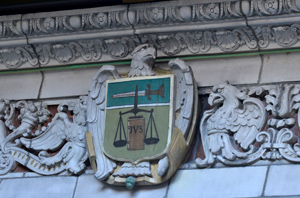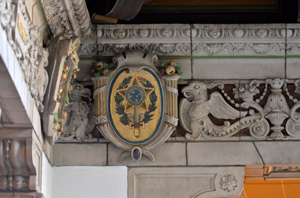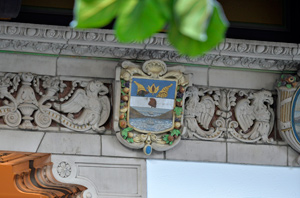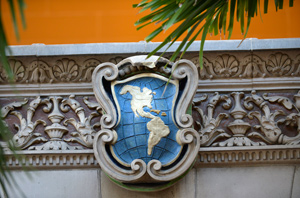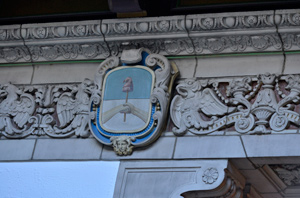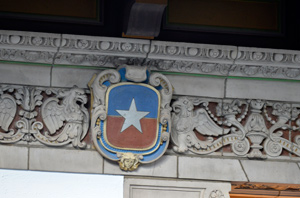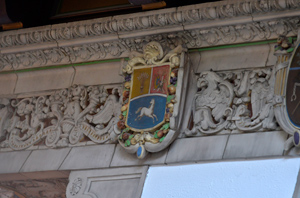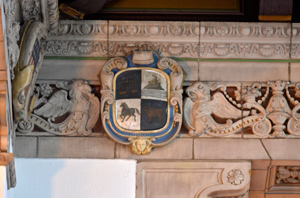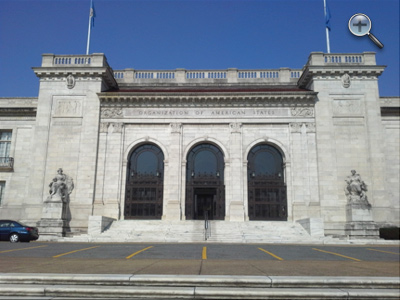- English
- Español
Coats of Arms and the Patio of the House of the Americas

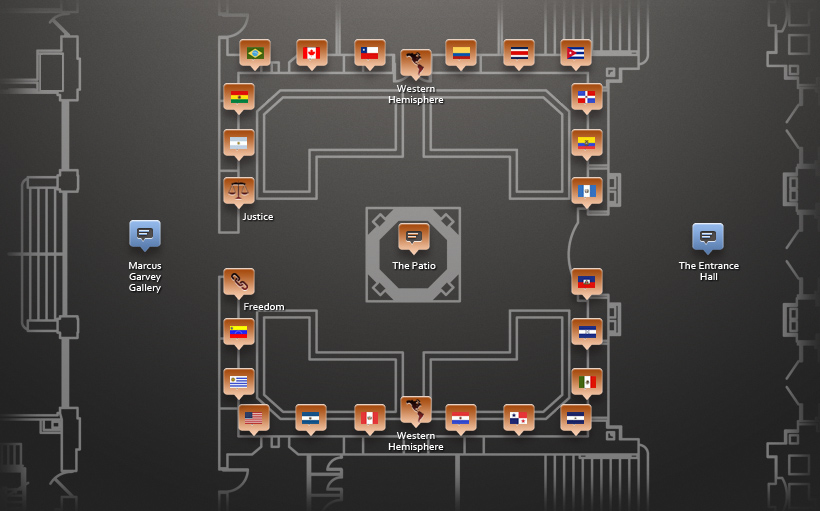
Peru
El Salvador
United States
The Marcus Garvey Gallery (Interior Gallery)
The Marcus Garvey Gallery, also known as the Interior Gallery, leads to the Liberator Simón Bolívar Room and is often used by the permanent missions to the OAS to present special exhibits. It is a rectangular room, similar in size to the Entrance Hall but only one-story high. It is paved in terrazzo with a dark-green marble perimeter, and its restrained decor consists mainly of busts and commemorative plaques.
The Entrance Hall
On entering the building, a vista draws the eye of the visitor through the three arches of the Entrance Hall deep into a series of interconnected spaces, through the filter of lush greenery of the central Patio and upwards toward the rear, where the balcony of the Gallery of Heroes and the entry to the Hall of the Americas terminate the visual ascent.
The Entrance Hall is a double-height rectangular space with a barrel-vaulted ceiling and marble floors. Three open arches, reiterating the three arched entries to the building, separate the Entrance Hall from the Patio. To the sides, at either end of the long Entrance Hall, pairs of black, white-veined “Grand Antique” marble columns with bronze capitals and bases mark the access to the grand stairs that flank the Patio and ascend to the second floor and the Hall of the Americas. Walls and vaults in the Entrance Hall are imitation Caen stone, whose symbolic decoration was adapted from the Capilla del Pocito of the Basilica of the Virgin of Guadalupe in Mexico City. The panels on the wall and ceiling vaults are enriched with garlands featuring maize and sunflowers, plants from the New World.
Four large bronze medallions are featured on the walls of the Entrance Hall, each topped with classical trophies of eagles, flags, arms and cornucopias. The two medallions above the entrance arches memorialize Law and Patriotism; facing these, the two over the central opening to the Patio celebrate Enlightenment and Peace.
On the left end of the Entrance Hall, beyond the paired marble columns, is a door crowned by a gold-lettered plaque surrounded by a large black frame profusely decorated with Mexican pre-Columbian motifs. The text provides a summary of the origins of the building and of the Pan American Union’s early administrative make-up, which changed with the adoption of the Charter of the OAS in 1948.
Western Hemisphere
Nicaragua
Panama
Paraguay
Haiti
Honduras
Mexico
Canada
Ecuador
The Patio
The interior Patio is the focal point of the OAS headquarters. It is a rectangular floor plan that has slightly raised planting beds at each corner, where rubber, cacao, coffee, palm and other tropical trees fill the space with lush greenery. Notable is the Peace Tree, a gift from U.S. President Taft when he dedicated the building in 1910. Enclosed on its four sides by walls with ample arcaded or trabeated openings, the two-story-high Patio is visually open to the sky through a glass roof. A red and cream terra cotta fret decorates the continuous wainscot of the perimeter wall. Centered on the north and south walls are doors directly under the balcony of the stair’s midway landing. Above each door, forming part of its decorative surround, are cartouches in glazed polychromed terra cotta depicting maps of the Western Hemisphere. Below roof level, a continuous decorative frieze embellishes the four perimeter walls. Twelve plaques bearing the names of New World heroes and leaders, together with 24 escutcheons, or coasts of arms, embellish this band. Twenty-one of the escutcheons represent the twenty-one republics that comprised the original International Union of American Republics. The twenty-second is the escutcheon of Canada, which joined the OAS in 1990. The remaining two—a scale and a broken chain—represent Justice and Freedom. The lintel soffits on the second-floor balconies have panels, also in glazed polychromed terra cotta, where a dove in a central patera symbolizes Peace. Inspired by the Municipal Palace of Barcelona, the bracketed roof eave, in polychromed wood, projects seven feet into the Patio space.
At the center of the Patio stands the beautiful pink-marble fountain designed by Gertrude Vanderbilt Vanderbilt Whitney. The space is filled with the sound of water cascading from two stacked basins into the octagonal fountain. On the sides of the second basin are carved figures taken from two of the principal native cultures of Mesoamerica: the Aztec and the Maya. They are separated by gargoyle-like stylized snake heads representing Quetzalcoatl, the “feathered serpent” and chief deity of the Aztecs. The central supporting pillar has three sculptured figures separated by stacked Mayan hieroglyphs. The first figure is a richly adorned Indian warrior or priest, inspired by the beautifully carved stelae of the Maya; the second is a young Indian male with an animal skin headdress and cape; and the third, a woman, as though half hidden in shadows.
In the area around the fountain and in the walkways and in the walkways between planters, the basket-weave pattern of the red-clay tile on the Patio floor is inlaid with black stone decorations inspired by Mayan art. At the east and west access to the Patio, these decorations depict images based on the bas-relief carvings of the Palace of Palenque, the Mayan archaeological site in the State of Chiapas, Mexico. On the main or eastern access, a standing priest or aristocrat holding a staff and ceremonial knife is flanked by two seated men, perhaps prisoners. Across the Patio, to the west, a man sits cross-legged on a stylized zoomorphic throne, receiving an offering from an individual below him. Another Patio sequence of four groups containing four figures is adapted from an altar in the Mayan city of Copán in Honduras. The paths leading away from the fountain also display two large tiles modeled after the pre-Inca site of Tiwanaku in Bolivia.
Guatemala
Bolivia
Freedom
Costa Rica
Dominican Republic
Cuba
Justice
Brazil
Colombia
Western Hemisphere
Argentina
Chile
Venezuela
Uruguay
Coats of Arms and Escutcheons
Below the central patio’s roof level, a decorative frieze adorns the four perimeter walls. The embellished band depicts the escutcheons or coats of arms of the 21 member states that comprised the original International Union of American Republics. The twenty-second coat of arms is that of Canada, which became a permanent member of the OAS in 1990. The remaining two escutcheons—a scale and a broken chain—symbolize Justice and Freedom. The decorated band is also made up of twelve plaques bearing the names of some of the most important heroes and leaders of the region, such as San Martín; Columbus; Washington; Martí; Hidalgo; Morazán; Champlain; Bolívar; O´Higgins; Artigas; Bonifacio, and Louverture.
At the same level, two oval escutcheons—made of glazed polychromed terra cotta—are located above the doors at the center of the northern and southern walls (under the staircases), which represent the Western Hemisphere.
Bienvenidos a la Casa de las Américas
La Casa de las Américas, sede de la Organización de los Estados Americanos (OEA), fue inaugurada en 1910, cuando la Organización hemisférica contaba con 21 Países Miembros. Hoy en día, la OEA cuenta con 34 miembros activos, y un total de 70 Observadores Permanentes.
Concebida como tributo a las numerosas culturas del Nuevo Mundo, la arquitectura beaux-arts de la Casa de las Américas es única por cuanto imprime a su modelo renacentista europeo un vocabulario arquitectónico hondamente enraizado en las tradiciones americanas. Su planta rectangular, organizada en torno a un patio central, reconoce sus orígenes en los diseños históricos de la antigua Grecia y Roma, más tarde depurados en la región mediterránea y de las Américas.
El predio fue adquirido en 1907 por la Junta Directiva de la Oficina Internacional de las Repúblicas Americanas, que por entonces era la Secretaría de la Unión Internacional de Repúblicas Americanas, fundada en 1889; y que antecedió a la Unión Panamericana, fundada en 1910, que a su vez precedió a la OEA, cuya fundación fue en 1948.
El majestuoso edificio de dos plantas se destaca en la esquina prominente del predio, con paredes exteriores de mármol de Georgia color blanco con vetas azules y un techo a dos aguas proyectado, de tejas de cerámica roja. Su fachada principal, orientada al Oeste, sobre la Calle 17, está articulada por órdenes corintios clásicos que destacan la triple arcada de que forman una entrada monumental. Los arcos están modulados por pilastras de capiteles ricamente ornamentados que sostienen un entablado intrincado de ménsulas, dentículos, modillones y otras decoraciones clásicas que, aunque típicas del estilo, utilizan motivos americanos. La importancia plástica de esta porción de la fachada central está realzada por altos pabellones de mármol que marcan cada extremo.
Además de los ornamentos botánicos corintios, la fachada de la Casa de las Américas incorpora numerosos elementos decorativos esculturales que simbolizan el objetivo de entendimiento y cooperación hemisféricos entre los países miembros de la OEA. Este programa ornamental incluye el uso reiterado de motivos, como la paz entre los países de las Américas, simbolizada por letras “P” y “A”, a veces entrelazadas; la estrella, elemento que figura en los símbolos nacionales de muchas naciones americanas, y la figura femenina de la paz, que aparece en cada capitel de pilastra, entre las clásicas hojas de acantos.
Entre las esculturas decorativas sobresalen dos grupos de tamaño mayor que el natural que, sobre pedestales que se elevan en la base de los pabellones laterales, flanquean la arcada de la entrada. Cada escultura es la figura de una mujer y de un joven que representan, respectivamente, los continentes norte y sur del Hemisferio Occidental. La que simboliza a Norteamérica está a la derecha, o al norte, y es obra de Gutzon Borglum; la que representa a Sudamérica, a la izquierda, o a l sur, es obra de Isidore Konti. La antorcha y la rama de olivo sostenidas en los alto pro las figuras femeninas de ambos costados representan el anhelo de sabiduría y paz, valores en que se asientan los principios del sistema interamericano. Los jóvenes protegidos por cada mujer simbolizan la juventud de los continentes y la promesa de futuro, sugerida por las alas en los tobillos y en las sienes del joven norteamericano y por la esfera que sostiene el joven sudamericano. En este último, el papagayo y la vegetación exuberante simbolizan la riqueza de Sudamérica en recursos naturales. Del lado norteamericano, la pequeña rueda mecánica y otras herramientas son alegorías de los albores industriales del continente norte.
El acceso de la calle al edificio está marcado por grandes antorchas de bronce que montan guardia a cada lado del primero de los dos tramos de la escalinata ceremonial de mármol que asciende a las tres grandes entradas en el arco del edificio, donde, como ornamentación en la piedra angular de cada arco, luce la letra “A”, que significa América. Las aberturas en arco presentan un extraordinario entramado ornamental inspirado directamente en el enrejado de la Catedral de Zaragoza, España. Al igual que el resto de la fachada, mucho de los detalles, que incluyen representaciones del águila y el cóndor que se miran cara a cara sobre el trazo elaborado de una letra “A”, rinden homenaje a las tradiciones culturales de Norteamérica y América Latina.
Sobre la entrada, inscrita centrada en el friso, luce una contrastante placa de mármol con el nombre de Organización, que en 1948, con la adopción de su Carta, fue cambiado a Organization of American States. A ambos extremos del friso aparecen paneles en relieve en los que predomina la figura de un niño y que representan respectivamente las raíces americanas nativas del Hemisferio y sus antecedentes europeos. Esculpidos por Isidore Konti, junto con los seis capiteles de las pilastras que están por debajo, cada panel muestra una figura sentada con una nutrida cornucopia, en referencia a la abundancia de recursos naturales de las Américas.
También obra de Konti e inscrito en los pabellones altos, encima de los grupos esculturales alegóricos, pueden verse dos paneles en altorrelieve que captan momentos importantes de la historia de Norteamérica y Sudamérica. En el panel sur, se ve una representación del encuentro de Guayaquil, en julio de 1822, entre el Libertador Simón Bolívar y el General José de San Martín, única reunión de estos dos héroes de la lucha por la independencia sudamericana. El panel norte muestra a George Washington despidiendo a sus generales al concluir la Revolución Americana y desbandarse las tropas del ejército continental.
Sobre el tejado, coronando la composición de la fachada central, se aprecia una balaustrada continua en mármol, cuyo ritmo es periódicamente interrumpido por sólidos dados del mismo material. En los altos del tejado, flamea la bandera de la OEA, como armonioso elemento que se integra a la silueta de la ciudad de Washington, DC.


